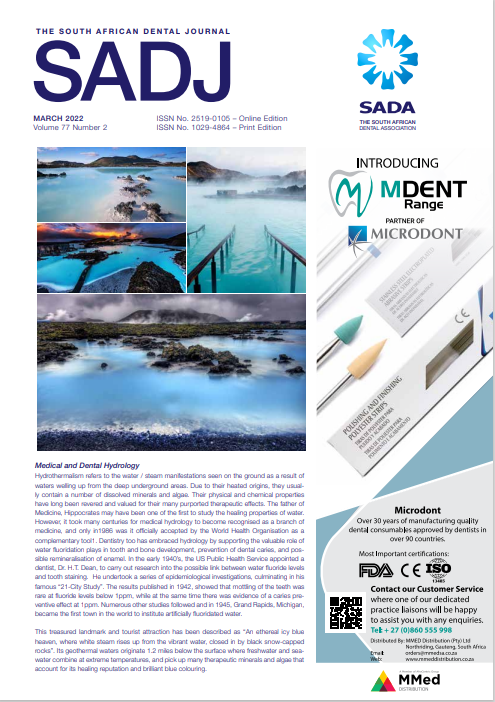Mandibular myiasis: A case report
DOI:
https://doi.org/10.17159/2519-0105/2022/v77no2a6Keywords:
Myiasis, maggot, oral, facial, infection, woundAbstract
Myiasis is a condition characterised by the infestation of live vertebrates with dipterous larvae. Myiasis is derived from the Greek word mya, meaning fly. Dipterans, (order Diptera), are two-winged insects known as true flies. Myiasis tends to occur in cutaneous, necrotic lesions of patients who have weak immune systems, who inhabit unhygienic environments. Maggot Debridement Therapy is an uncommon treatment of debriding necrotic tissue, with some utility. A case of mandibular myiasis involving a malignant mandibular lesion that was colonised by maggots is discussed.
Downloads
References
Francesconi F, Lupi O. Myiasis. Clin Microbiol Rev. 2012; 25 (1): 79-105 DOI: https://doi.org/10.1128/CMR.00010-11
Oldroyd H. Dipteran [internet]. Britannica [cited 2020 December 30]. Available from: https://www.britannica. com/animal/dipteran
Whitaker IS, Twine C, Whitaker MJ, Welck M, Brown CS, Shandall A. Larval therapy from antiquity to the present day: mechanisms of action, clinical applications and future potential. Postgrad Med J. 2007; 83(980): 409-413. DOI: https://doi.org/10.1136/pgmj.2006.055905
Kuria SK, Kingu HJC, Villet MH, Dhaffala A. Human myiasis in rural South Africa is under-reported. SAMJ. 2015; 105(2): 129-133. DOI: https://doi.org/10.7196/SAMJ.8118
Donnelly J. Wound healing--from poultices to maggots. (A short synopsis of wound healing throughout the ages). Ulster Med J. 1998; 67(1): 47-51.
Derraik JGB, Heath A, Rademaker M. Human myiasis in New Zealand: imported and indigenously-acquired cases: the species of concern and clinical aspects. NZ Med Jour.2010; 123: 21-38.
Downloads
Published
Issue
Section
License

This work is licensed under a Creative Commons Attribution-NonCommercial 4.0 International License.






.png)